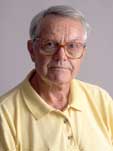Mr. McKee came to Greenvile, NC in 1974 as plant engineer for Proctor and Gamble, and retired in 1987 after 38 years of service. He led a very active civic life, including serving on the Greenville City- Council from 1979 to 1981. He was active in helping form the first hospice group in Greenville. He served on the board of Evergreen, the original downtown improvement effort, and continued to serve with the Uptown Greenville organization. He was active on the board of the Greenville Museum of Art and pushed for the museum to hire a professional to raise funds for capitol improvements. Mr. McKee volunteered as a third- and fourth-grade math tutor and returned to East Carolina University as a student of Art. He used his artistic ability to paint pastel portraits for the past 20 years. Mr. Richard Jay “Dick” McKee, 82, died Wednesday, March 10, 2004, at his home.He is survived by his wife of 61 years, Mae McKee; two daughters, Marsha McKee and husband, William Fridrich, of Wilmington, and Cameron McKee Mackey and husband, David, of Little Rock, Arkansas.; and two grandsons, Charles Ford Mackey and Benjamin Drew Mackey. |
WRIGHT “CYCLONE” ENGINES In the early 1940s, Wright “Cyclone” engines were manufactured at a large plant near Cincinnati, Ohio. The plant was operated by the Wright Aeronautical Corporation, and I worked there from the fall of 1941 to the spring of 1943. While the engines made in this plant were not the same model as those on the B-17, they were installed on other bombers and fighters. The engines on a B-17 were 9 cylinder radials, and the ones made in Cincinnati were 14 cylinder; two banks of 7 cylinders each and therefore were larger and had more power. In the fall of 1941, I was 20 years old [close to the same age as Maurice] and was beginning my third year as a “Co-op” student in Aeronautical Engineering at the University of Cincinnati. As a co-op student, I worked and went to school on a repeating seven week cycle. There was a Coordinator at the university who arranged for employment at the various businesses in the area that were willing to hire co-op students. Each job was held by two students who alternated with each other to fill the position full-time. In that way we worked and studied year round, and gained valuable experience in our fields before we were graduated. And we made money! This was an excellent way to work oneself through college. I and my alternate were eventually to become part of the Engineering Department at the Wright Aeronautical Corporation, but first we were assigned to various other departments in order to learn how the engines were made. We spent time in the Foundry, the Quality Assurance Lab and the Engine Test Department before being assigned to Engineering. In the Foundry, magnesium cylinder heads were cast, as well as numerous aluminum parts. In the lab, many tests were performed on parts and material to make sure that they met specifications. After assembly, each engine was ‘run-in’ on a test stand in a test cell to make sure that it would perform properly before shipping it to the aircraft manufacturer. Once having joined the Engineering Department, our work was to follow ‘Engineering Changes,’ so named because they were approved changes to design, fabrication, material, assembly or other factors. These changes were intended to improve the engines. Each change was identified so it could be followed through the steps of manufacture and checked to see that it solved the problem and/or made the improvement as intended. In the course of following these changes we had to visit many of the different stages of fabrication and assembly of the engines. Although our engines were not on the B-17s, they may have been on the B-24s that participated in the 2nd Schweinfurt Raid, of which Maurice was a part. Introduction Mission Overview My 2nd Schweinfurt Life as a POW |

